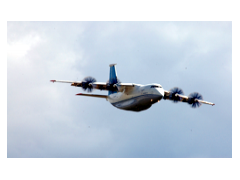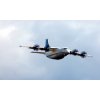The AN-70 aircraft belongs to a new generation of the short takeoff and landing tactical military medium transports. AN-70 is extremely required by army. This aircraft is capable of solving qualitatively new tasks beyond possibilities of previous military transports. It was proved by the wide programme of the Joint State tests, main part of which had been completed. AN-70 can transport almost any item of aeromobile military and engineering vehicles used by armies of the world and to deliver them to poorly-equipped unpaved runways directly to the destination. On this ability, AN-70 surpasses all the existent airplanes.
AN-70 can perform the typical transport mission (transportation of 20 t payload at a range of 3000 km) from unpaved airfield of 600-800 m length only. There is no other airplane with such ability. Taking into account all likely possibilities it is possible to come to conclusion that the AN-70 STOL capabilities as much as twice reduce both the number of aircraft required for the mission and the cost of the operation. According to the design estimations, AN-70 can be operated from/to elevated airfields placed at altitudes up to 3000 m over sea level. In comparison with the analogues aircraft, the AN-70 can perform air dropping of cargoes and parachutists with twice less scatter and its crew can guide the aircraft to the calculated touchdown point with a pin-point accuracy.
Four D-27 engines with SV-27 counter-rotating propfans ensure a high cruising speed and 20-30% fuel economy in comparison with modern turbojet airplanes.
The built-in aerial delivery system ensures autonomous loading/unloading of a wide range of cargoes and their air dropping. The onboard loading equipment consists of four overhead rail electric motor hoists and two onboard electric winches. At customer request, the aircraft can be equipped with easily removable upper deck or roller conveyer to automate container handling operations.
onboard monitoring and diagnostic systems make possible the autonomous operation of the AN-70 aircraft from poorly equipped airfields without the need for any special ground facilities. Aircraft maintenance is based on the “on-condition” strategy.
The AN-70 is fitted with modern electronic equipment and systems of fully digital control. The AN-70 is competitive enough as for the airframe and power pant characteristics as well as airborne system. The first production AN-70s constructed at ANTonOV Serial Plant will have modern configuration of electronic equipment.
In January 2015, the AN-70 was adopted by Armed Forces of Ukraine. At present, the aircraft is passing Special Tests programme.
a3 AN-225 Mriya / Super Heavy Transport
This unique transport airlifter was designed and constructed during 1984-1988.
The aircraft has been created to perform the following missions:
transportation of various cargoes (large-sized, heavy, long-size) with total weight up to 250 t.;
intercontinental non-stop airlift of cargoes weighting 180−200 t;
intercontinental airlift of cargoes with weight up to 150 t;
transportation of a heavy large-size single pieces with weight up to 200 t on the external store.
Mriya had to become the first stage of the system of the aerial launch of a space ship, flying cosmodrome, from which a space shuttle with a tank havin total mass of 170 t had to start to the orbit. Initially, the main task of the AN-225 was transportation of various parts of Energiya carrier-rocket and Buran space ship, which had been manufactured at the enterprises of central regions of the USSR, and final assembly should have been performed at Baikonour. Projected length of some of them reached 60 meters and diameter – 8 meters. Range of transportation was 1500-2500 km. Besides, depending to mission, performed on the orbit, Bouran could land on different airdromes. From there it was necessary to deliver it again to Baikonour, to the place of previous launch.
Mriya with Buran on its external store performed 14 flights with total duration of 28 hours and 27 minutes. They had been performed from the airfields located in various climatic zones of the USSR: in Gostomel, Akhtoubinsk, Baikonour, Borispol, Vnukovo, Yelizovo, Ramenskoye, Chkalovskaya, Khabarovsk. However, after collapse of the USSR, financing of Energiya-Bouran programme was terminated and the project stopped.
In 2000, modernization of the AN-225 was started. The aim was use of the airplane for transportation of commercial cargoes. The decision had been taken due to many applications sent to Antonov Airlines for transportation of cargoes heavier than the AN-124-100 Ruslan’s payload. Than Mriya passed certification tests and on May 23, 2001, Aviation Register of Interstate Aviation Committee (AR IAC) and Ukraviatrans issued type certificates to the AN-225. Since that till present, the airplane has been performing commercial transportations in the fleet of Antonov Airlines, transport subdivision of ANTonOV Company.
The aircraft has the spacious cargo compartment with length of 43,32 m, width of 6.4 m and height of 4.4 m, that allows carrying a variety of cargoes inside. For instance,
sixteen standard aeronautical containers of UAC−10 type;
50 cars;
single piece of cargoes up to 200 t (turbines, generators, dump trucks − Belaz, Kamatsu, Euclid, etc.).
The cargo compartment is pressurized that extends the aircraft transport capabilities. The airborne cargo handling equipment and also the design of the forward cargo door with a ramp ensure the quick and easy loading/unloading operations. The aircraft is capable to transport the unique cargoes outside the fuselage which dimensions do not allow to place them at the other land-base vehicles and aircraft. There is an appropriate load security system to attach these cargoes to the fuselage.
Mriya has set up 240 world records including transportation of the heaviest cargo with mass of 253 tons, the heaviest single peace of cargo with mass of 186,7 t as well as the longest cargo havin length of 42,1 m. But the main thing is that Mriya serves people reliably. The airplane repeatedly participated in humanitarian operations. Thus in October, 2009 the AN-225 performed several flights on delivery generators to Samoa. They were necessary for renewal of work of Satala electric station damaged by tsunami. only spacious cabin of the AN-225 could accommodate ten 12-tons generators at once. Each of them was as large as 6-meters container. Felise Kaisia, representative of the Centre on extraordinary situation of interior troops of Samoa, said: “Generators were fully destroyed by the waves, that is why electric station in the centre of Satala which supplies energy to all eastern coast had been stopped. By this reason namely delivery of new generators in the shortest terms was so necessary”.
In February 2010, Mriya transported large-size construction machinery (bulldozers, trucks, tractors, loaders) for liquidation of aftermath of earthquake on Haiti. Cargo weighing 108 tons was delivered from Tokyo (Japan) to Santo-Domingo (Dominican Republic) by order of government of Japan, and after it by ground – to Port-au-Prince, the capital of Haiti. They chose Mriya taking into account necessity of urgent delivery. Its spacious cabin only could contain such a large cargo.
On March 25, 2011, the AN-225 Mriya delivered to Japan humanitarian cargoes, generators and technique with total mass of 140 t. The AN-225 landed in Narita airport (Tokyo). The flight had been performed by order of French government.
Researches on use of the AN-225 as the first stage of a space complex for commercial launches of the useful cargoes into space is in progress. One of the most advanced projects is the MAKS joint Russian/Ukrainian multipurpose aerospace system. It foresees delivery of the 8.5-10 tons of useful load in a piloted version and 18-19 tons in unmanned version to the orbit.
In 2009 works on the extension of the aircraft life time up to 25 years as well as on upgrading avionic and other equipment were performed.





